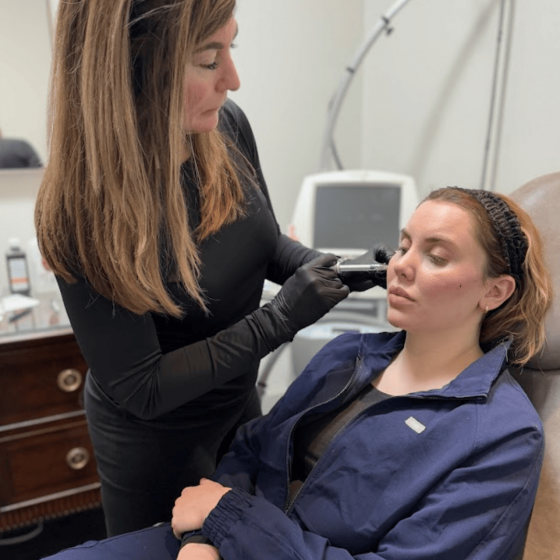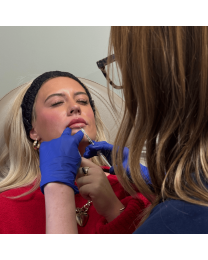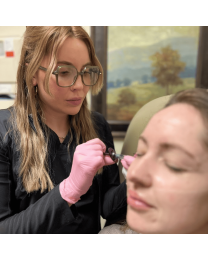Buy Any 2 1.0 Syringe of Dermal Filler and Get the 3rd 1.0 Syringe for 50% OFF
*Individual syringes only. Add 3 to cart and discount will apply.
Dynamic wrinkles and folds appear in areas of the face that move repetitively. Your face is dynamic, making millions of movements and micro-movements every day. Movements like squinting, frowning, laughing, and talking create dynamic wrinkles and folds. These wrinkles and folds can be difficult to treat because dermal fillers may cause the area to appear stiff or unnatural when the face moves.
RHA® Collection is designed to be resilient enough to adapt to your facial movement, which may provide a more natural look at rest and in motion.
| Benefits |
|
|---|---|
| FAQs | What happens in the doctor’s office before the treatment?Note that each doctor may have their own process for treating patients. Before the injection procedure, your doctor will ask you questions about your medical history. He/she will ask about your treatment goals. Your doctor will discuss whether you are a good candidate for RHA® 3. He/she will review with you what to expect during and after treatment, including possible risks. During this discussion, it is very important to tell your doctor about: • all medications you are taking, both over the counter and prescription • any previous facial treatment you may have received • and any health conditions for which you are receiving medical attention Your doctor will also examine your skin in and around the treatment area, and may take photos. The treatment area will be cleaned and prepared with a cleansing agent. Your doctor may use a pen to mark your face in the planned areas of injection. Do the injections hurt?Injections may cause some pain during and after the procedure. Your doctor will discuss different options for pain management with you. RHA® 3 contains an anesthetic medicine (lidocaine) to help reduce injection site pain. This pain is temporary, and usually lessens within a few minutes. To prevent or reduce pain from the injection, your doctor may use ice packs, or other anesthetic, both before and after the injection. What happens during the treatment?RHA® 3 is slowly injected into the facial skin in small amounts until your doctor sees the desired result which creates a more youthful appearance of the face. For most patients, the procedure only takes 15-30 minutes. Once your doctor has finished injecting the treatment area, he/she may gently massage your face to help smooth and distribute the gel evenly. Your doctor may also apply an ice pack to help decrease swelling and pain. The amount of RHA® 3 used depends on the depth of your wrinkles and your treatment goals. The right amount to be injected will be decided by your doctor during the procedure. Injection of additional RHA® 3 (touch-up treatment) may be needed 2 to 4 weeks after initial treatment to achieve the desired aesthetic outcome. In the clinical study, 68% of the patients received a touch-up treatment 2 weeks after initial treatment to achieve their desired results. Your doctor will decide how much RHA® 3 is needed for the touch-up treatment. What happens after the treatment?Your doctor may advise you to apply cold compresses to the treated area to help reduce pain and swelling. In order to prevent injury, ask your doctor how long you can leave ice packs on the treated area. Be aware that numbness, short term loss of touch or feeling, and tingling around the injection area may occur due to the numbing medicine (anesthetic). It usually goes away within a few hours. Due to this numbness, you may not have normal feeling of hot or cold in this area. Ask your doctor about any limits for exercising and exposure to sun, cold or heat (sauna, steam room). Exposure to any of these for the first 24 hours may increase short term redness, swelling, and/or itching at the injection site. You should ask your doctor when make-up may be applied after your treatment. Using make-up too soon may increase the risk of infection or change in skin color. Most common treatment reactions like bruising, firmness, swelling, pain, tenderness, redness, lumps/bumps, change of skin color and itching go away on their own within a few days, but your doctor may choose to treat them with medications. Refer to section 7, RISKS. When should I call my doctor?Call your doctor if you have any questions or concerns after your procedure. 4 Call your doctor immediately if you have: • Signs of a stroke (including sudden difficulty speaking, numbness or weakness in your face, arms, or legs, difficulty walking, face drooping, severe headache, dizziness, or confusion) • Changes in your vision • Pain which increases after your treatment • Significant pain away from the injection site • White appearance of the skin • Any treatment reaction other than bruising, firmness, swelling, pain, tenderness, redness, lumps/bumps, change in skin color or itching, which occurs in the first two weeks • Any treatment reaction in the treated area, including lump or hardening under the skin, that appears weeks or months after your injection The following are common reactions often seen after treatment with dermal fillers. They usually go away within 2 weeks. If you are concerned, or if they last more than 2 weeks, call your doctor:
|
| Treatment Type | Filler, Injectables |
| Treatment Problem or Condition | Facial Volume Loss, Wrinkles |
| Brand | Revance® |
RHA® is injected into the skin with an ultrafine needle to plump the skin to fill in and smooth away wrinkles and folds such as the lines from your nose to the corners of your mouth. This smoothing effect has been shown to last 12 months in 85% of the patients (53 out of 62 patients) and lasted 15 months in 81% of the patients (38 out of 47 patients).
RHA® is not a permanent gel. It slowly goes away as the body absorbs the gel. The smoothing and plumping effect will gradually disappear.
The RHA® Collection is made with a gentle manufacturing process. This gentle process helps preserve the natural structure of the hyaluronic acid, allowing it to more closely resemble the natural hyaluronic acid in your skin.









